display SKODA SUPERB 2005 1.G / (B5/3U) DX Navigation System Manual
[x] Cancel search | Manufacturer: SKODA, Model Year: 2005, Model line: SUPERB, Model: SKODA SUPERB 2005 1.G / (B5/3U)Pages: 75, PDF Size: 3.09 MB
Page 33 of 75

RADIO NAVIGATION SYSTEM32
NAVIGATION
Enter destination - Town centre
Selecting a town centre (town
district) as the destination
In large cities/towns, you can use the “Town
centre” menu field to select part of the town as
your destination.
For smaller towns and villages, you can use
this menu field to select the town centre as your
destination because the information that can
be entered in the “Street” menu field is limited.
Selecting the “Town centre” menu field
•Mark and confirm the “Town centre” menu
field in the enter destination menu.
One of the following will appear in the display:
– the list (for a maximum of 14 entries)
– the edit menu (for more than 14 entries)
Selecting the centre
•Enter the name of the town centre in the
edit field or confirm an existing entry.
•Then access the list.
•Mark and confirm the desired town centre
on the list.
The main navigation menu will appear.
Now you can begin route guidance (see page
44).
Notes
For large cities, the list will also display parts
of the city.
If the town centre (or part of the town) select-
ed appears more than once in the list, a sub-
menu will appear from which you can select
the desired entry.
Entering special destinations
Use the “Special dests.” menu field in the en-
ter destination menu to enter other destina-
tions.
Special destinations include:
Close to address - these are destinations
that are close to the destination address se-
lected (e.g. car park, petrol station, ·kodaAuto
service centre, etc.)
Supraregional destinations - these are des-
tinations that are not allocated to any specific
location (e.g. border crossing, airport, etc.)
Close to location - these are destinations
that are close to your current vehicle location
(this function is particularly useful if you want
to find such locations as the closest petrol sta-
tion or a ·kodaAuto service centre).
The destination is then selected from catego-
ries, which are stored in alphabetical order. Dif-
ferent categories will appear, depending on the
special destination.
These categories can include:
– Exhibition grounds
– Motorway service
– Car park/indoor parking
– ·koda Auto service.
If there is no information available for a cate-
gory, the selection bar will automatically move
to the next category.
After you have selected the category, you can
use the edit menu and the list to select the
desired destination.
Enter destination - Special destinations
Page 36 of 75

RADIO NAVIGATION SYSTEM35
NAVIGATION
Selecting an entry from the list
The display will show a list of destinations in
the surrounding area. The list will indicate des-
tinations in the area surrounding your current
vehicle location. The list will also show the dis-
tance from your current vehicle location to the
destination. The destination entries on the list
are sorted according to how far they are from
your vehicle location.
•Mark and confirm the desired destination.
The main navigation menu will appear, the des-
tination you have selected will appear in the
destination field.
Now you can start route guidance (see page
44).
Storing a destination in the
destination memory
You must first save a destination in the desti-
nation memory before you can use this func-
tion.
A destination is initially saved in the alpha-
betical destination memory . The
destinations are sorted alphabetically by
their short name (if you have assigned them
one), town name, street name, and
intersection or house number.
Then you can also save the destination in the
Top 10 memory . These destinations will ap-
pear in the order selected by the user . The
memory can store a maximum of 10 entries
and helps you to find destinations you drive
to frequently more easily.
You can allocate a short name (e.g.
someone’s first name) to a destination. This
will make it easier for you to find the
destinations in the destination memory later.
Enter destination - From the
destination memory
You can access the destination memory menu
directly from the main navigation menu by us-
ing the “Dest. memory” menu field. Selecting the “Store destination” menu field
Use this function to save the destination ad-
dress currently shown in the destination field
in the alphabetical destination memory.
•Confirm the menu field. (The “Store desti-
nation” menu field is already marked when you
access this menu.)
Then the edit menu will appear so that you can
assign a short name to the destination.
Page 39 of 75

RADIO NAVIGATION SYSTEM38
NAVIGATION
Selecting a stored destination
The name of the memory selected will appear
in the menu line (here: Top 10). If you select
the alphabetical memory, the term “Alphabet.
memory” will appear.
Note
In the Top 10 memory, “free” indicates that
there is no destination stored at this position.
•Mark the desired entry.
Turn the menu knob to the left to move the
selection bar down and to the right to move
the selection bar up.
•Confirm your selection.
The main navigation menu will appear, the des-
tination selected will appear in the destination
field.
Now you can start route guidance (see page
44).
Note
You can also start route guidance directly from
the memory.
Mark the desired entry and press the menu
knob (for longer than 2 seconds) to confirm
your selection. Route guidance for the
destination selected will begin.
Enter destination - To the flagged
destination
Setting your current vehicle location
as the flagged destination
Use ## ##
# to mark your current vehicle location
as a flagged destination and to save it in the
destination memory. One example of such a
destination could be an interesting place you
would like to return to later.
Note
Make sure that the system indicates the street
name at the bottom of the display. Otherwise
it might not be possible to calculate route
guidance to this destination later because it is
not located on a street that the system is able
to identify
When you mark the flagged destination you will
hear a short beep.
If you mark several flagged destinations one
after the other, only the last one marked will
be stored in the memory.
If you have saved a flagged destination in the
destination memory, you can use in at a later
date to enter your destination.
Page 44 of 75
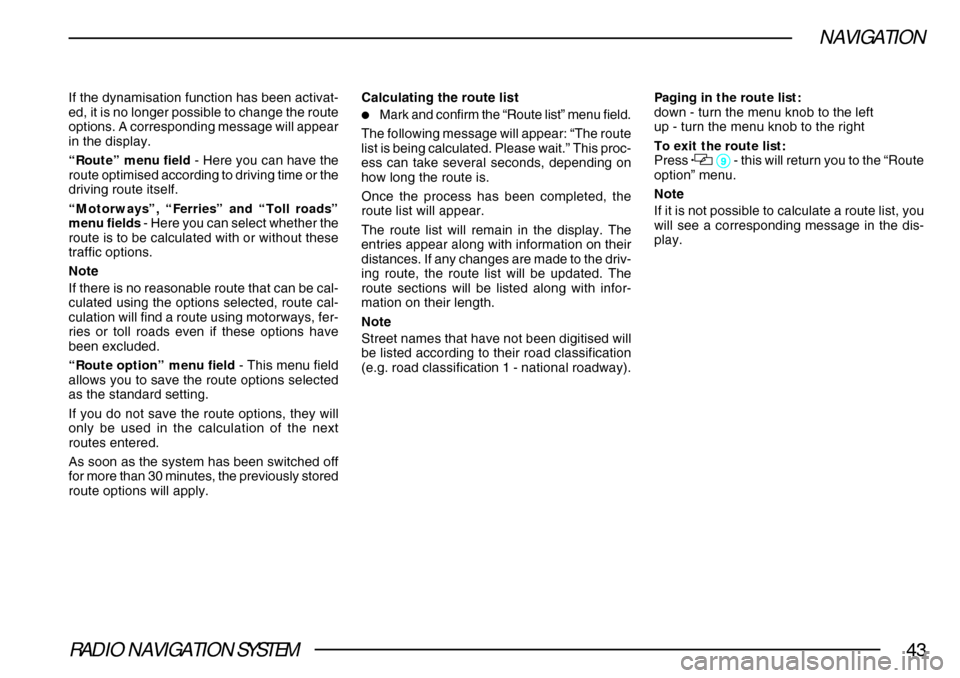
RADIO NAVIGATION SYSTEM43
NAVIGATION
If the dynamisation function has been activat-
ed, it is no longer possible to change the route
options. A corresponding message will appear
in the display.
“Route” menu field - Here you can have the
route optimised according to driving time or the
driving route itself.
“Motorways”, “Ferries” and “Toll roads”
menu fields - Here you can select whether the
route is to be calculated with or without these
traffic options.
Note
If there is no reasonable route that can be cal-
culated using the options selected, route cal-
culation will find a route using motorways, fer-
ries or toll roads even if these options have
been excluded.
“Route option” menu field - This menu field
allows you to save the route options selected
as the standard setting.
If you do not save the route options, they will
only be used in the calculation of the next
routes entered.
As soon as the system has been switched off
for more than 30 minutes, the previously stored
route options will apply. Calculating the route list
•Mark and confirm the “Route list” menu field.
The following message will appear: “The route
list is being calculated. Please wait.” This proc-
ess can take several seconds, depending on
how long the route is.
Once the process has been completed, the
route list will appear.
The route list will remain in the display. The
entries appear along with information on their
distances. If any changes are made to the driv-
ing route, the route list will be updated. The
route sections will be listed along with infor-
mation on their length.
Note
Street names that have not been digitised will
be listed according to their road classification
(e.g. road classification 1 - national roadway). Paging in the route list:
down - turn the menu knob to the left
up - turn the menu knob to the right
To exit the route list:
Press
99 99
9 - this will return you to the “Route
option” menu.
Note
If it is not possible to calculate a route list, you
will see a corresponding message in the dis-
play.
Page 45 of 75
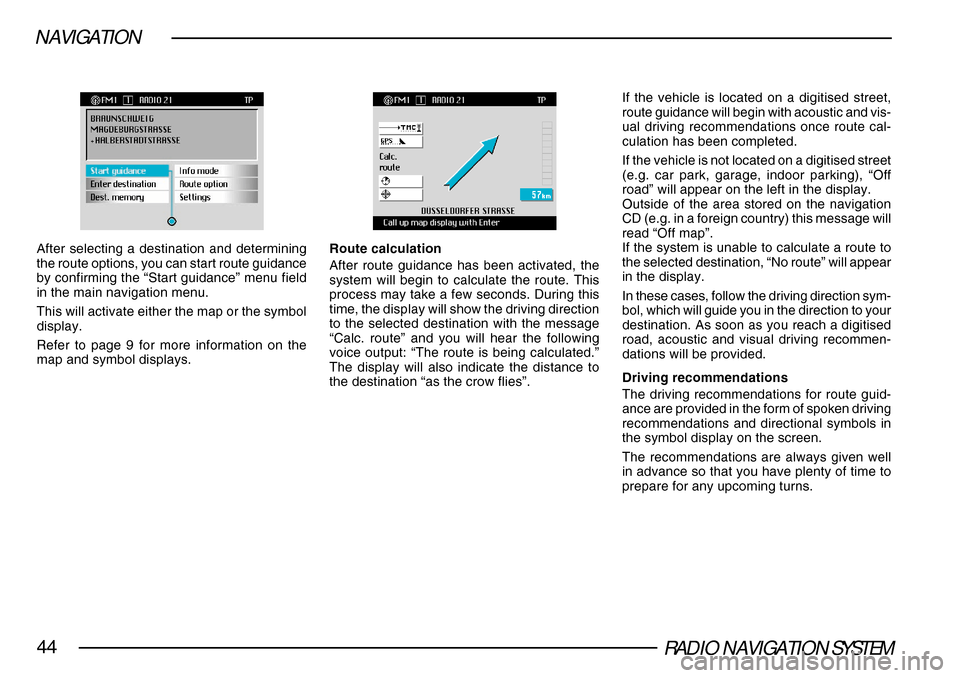
RADIO NAVIGATION SYSTEM44
NAVIGATION
After selecting a destination and determining
the route options, you can start route guidance
by confirming the “Start guidance” menu field
in the main navigation menu.
This will activate either the map or the symbol
display.
Refer to page 9 for more information on the
map and symbol displays.Route calculation
After route guidance has been activated, the
system will begin to calculate the route. This
process may take a few seconds. During this
time, the display will show the driving direction
to the selected destination with the message
“Calc. route” and you will hear the following
voice output: “The route is being calculated.”
The display will also indicate the distance to
the destination “as the crow flies”.If the vehicle is located on a digitised street,
route guidance will begin with acoustic and vis-
ual driving recommendations once route cal-
culation has been completed.
If the vehicle is not located on a digitised street
(e.g. car park, garage, indoor parking), “Off
road” will appear on the left in the display.
Outside of the area stored on the navigation
CD (e.g. in a foreign country) this message will
read “Off map”.
If the system is unable to calculate a route to
the selected destination, “No route” will appear
in the display.
In these cases, follow the driving direction sym-
bol, which will guide you in the direction to your
destination. As soon as you reach a digitised
road, acoustic and visual driving recommen-
dations will be provided.
Driving recommendations
The driving recommendations for route guid-
ance are provided in the form of spoken driving
recommendations and directional symbols in
the symbol display on the screen.
The recommendations are always given well
in advance so that you have plenty of time to
prepare for any upcoming turns.
Page 46 of 75
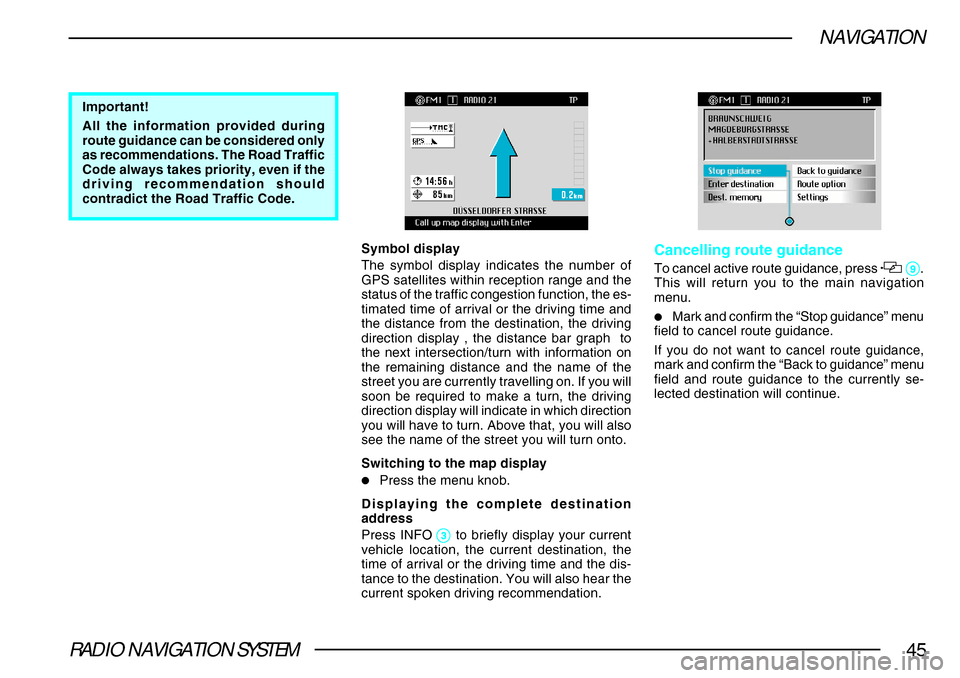
RADIO NAVIGATION SYSTEM45
NAVIGATION
Important!
All the information provided during
route guidance can be considered only
as recommendations. The Road Traffic
Code always takes priority, even if the
driving recommendation should
contradict the Road Traffic Code.
Symbol display
The symbol display indicates the number of
GPS satellites within reception range and the
status of the traffic congestion function, the es-
timated time of arrival or the driving time and
the distance from the destination, the driving
direction display , the distance bar graph to
the next intersection/turn with information on
the remaining distance and the name of the
street you are currently travelling on. If you will
soon be required to make a turn, the driving
direction display will indicate in which direction
you will have to turn. Above that, you will also
see the name of the street you will turn onto.
Switching to the map display
•Press the menu knob.
Displaying the complete destination
address
Press INFO
33 33
3 to briefly display your current
vehicle location, the current destination, the
time of arrival or the driving time and the dis-
tance to the destination. You will also hear the
current spoken driving recommendation.
Cancelling route guidance
To cancel active route guidance, press 99 99
9.
This will return you to the main navigation
menu.
•Mark and confirm the “Stop guidance” menu
field to cancel route guidance.
If you do not want to cancel route guidance,
mark and confirm the “Back to guidance” menu
field and route guidance to the currently se-
lected destination will continue.
Page 47 of 75
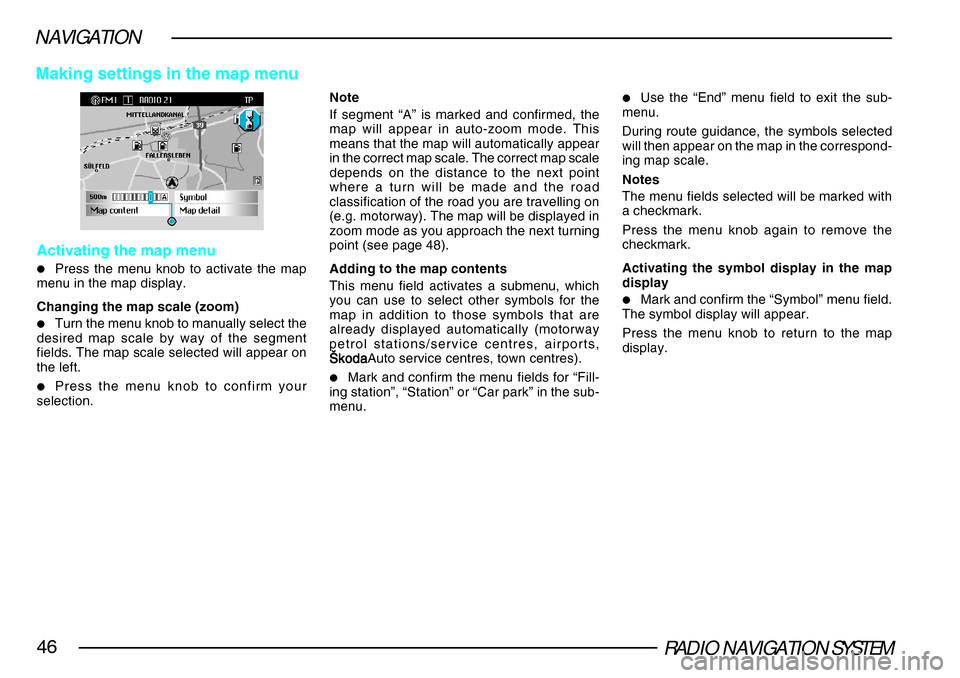
RADIO NAVIGATION SYSTEM46
NAVIGATION
Activating the map menu
•Press the menu knob to activate the map
menu in the map display.
Changing the map scale (zoom)
•Turn the menu knob to manually select the
desired map scale by way of the segment
fields. The map scale selected will appear on
the left.
•Press the menu knob to confirm your
selection. Note
If segment “A” is marked and confirmed, the
map will appear in auto-zoom mode. This
means that the map will automatically appear
in the correct map scale. The correct map scale
depends on the distance to the next point
where a turn will be made and the road
classification of the road you are travelling on
(e.g. motorway). The map will be displayed in
zoom mode as you approach the next turning
point (see page 48).
Adding to the map contents
This menu field activates a submenu, which
you can use to select other symbols for the
map in addition to those symbols that are
already displayed automatically (motorway
petrol stations/service centres, airports,
·koda·koda ·koda·koda
·kodaAuto service centres, town centres).•Mark and confirm the menu fields for “Fill-
ing station”, “Station” or “Car park” in the sub-
menu.
•Use the “End” menu field to exit the sub-
menu.
During route guidance, the symbols selected
will then appear on the map in the correspond-
ing map scale.
Notes
The menu fields selected will be marked with
a checkmark.
Press the menu knob again to remove the
checkmark.
Activating the symbol display in the map
display
•Mark and confirm the “Symbol” menu field.
The symbol display will appear.
Press the menu knob to return to the map
display.
Making settings in the map menu
Page 48 of 75
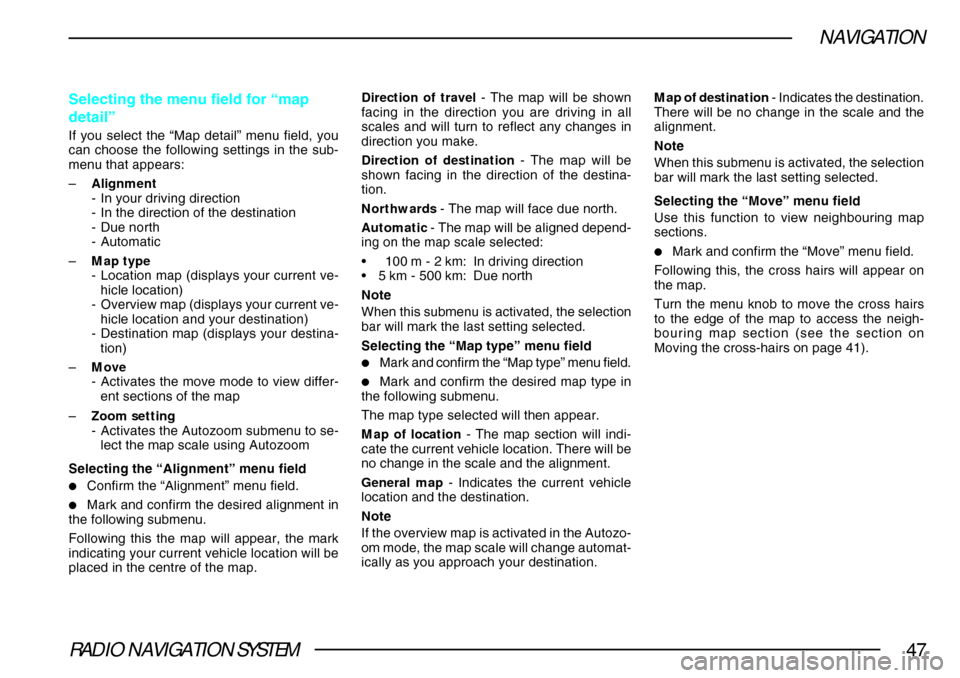
RADIO NAVIGATION SYSTEM47
NAVIGATION
Selecting the menu field for “map
detail”
If you select the “Map detail” menu field, you
can choose the following settings in the sub-
menu that appears:
–Alignment
-In your driving direction
- In the direction of the destination
- Due north
- Automatic
– Map type
-Location map (displays your current ve-
hicle location)
- Overview map (displays your current ve-
hicle location and your destination)
- Destination map (displays your destina-
tion)
– Move
-Activates the move mode to view differ-
ent sections of the map
– Zoom setting
-Activates the Autozoom submenu to se-
lect the map scale using Autozoom
Selecting the “Alignment” menu field
•Confirm the “Alignment” menu field.
•Mark and confirm the desired alignment in
the following submenu.
Following this the map will appear, the mark
indicating your current vehicle location will be
placed in the centre of the map. Direction of travel
- The map will be shown
facing in the direction you are driving in all
scales and will turn to reflect any changes in
direction you make.
Direction of destination - The map will be
shown facing in the direction of the destina-
tion.
Northwards - The map will face due north.
Automatic - The map will be aligned depend-
ing on the map scale selected:
• 100 m - 2 km: In driving direction
•5 km - 500 km: Due north
Note
When this submenu is activated, the selection
bar will mark the last setting selected.
Selecting the “Map type” menu field
•Mark and confirm the “Map type” menu field.
•Mark and confirm the desired map type in
the following submenu.
The map type selected will then appear.
Map of location - The map section will indi-
cate the current vehicle location. There will be
no change in the scale and the alignment.
General map - Indicates the current vehicle
location and the destination.
Note
If the overview map is activated in the Autozo-
om mode, the map scale will change automat-
ically as you approach your destination. Map of destination
- Indicates the destination.
There will be no change in the scale and the
alignment.
Note
When this submenu is activated, the selection
bar will mark the last setting selected.
Selecting the “Move” menu field
Use this function to view neighbouring map
sections.
•Mark and confirm the “Move” menu field.
Following this, the cross hairs will appear on
the map.
Turn the menu knob to move the cross hairs
to the edge of the map to access the neigh-
bouring map section (see the section on
Moving the cross-hairs on page 41).
Page 49 of 75
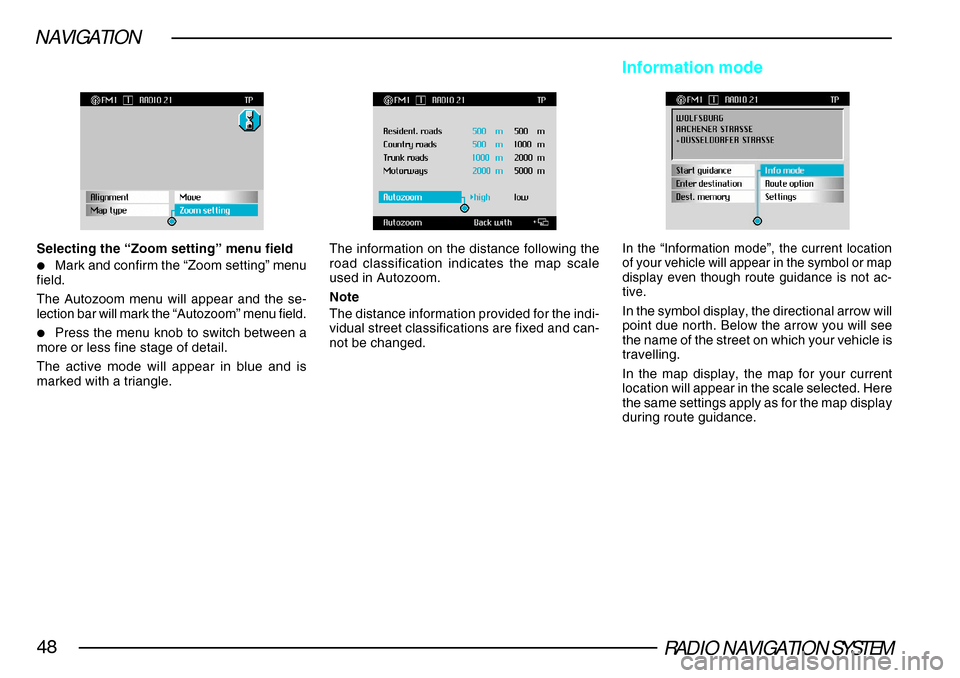
RADIO NAVIGATION SYSTEM48
NAVIGATION
Selecting the “Zoom setting” menu field
•Mark and confirm the “Zoom setting” menu
field.
The Autozoom menu will appear and the se-
lection bar will mark the “Autozoom” menu field.
•Press the menu knob to switch between a
more or less fine stage of detail.
The active mode will appear in blue and is
marked with a triangle.
The information on the distance following the
road classification indicates the map scale
used in Autozoom.
Note
The distance information provided for the indi-
vidual street classifications are fixed and can-
not be changed.
Information mode
In the “Information mode”, the current location
of your vehicle will appear in the symbol or map
display even though route guidance is not ac-
tive.
In the symbol display, the directional arrow will
point due north. Below the arrow you will see
the name of the street on which your vehicle is
travelling.
In the map display, the map for your current
location will appear in the scale selected. Here
the same settings apply as for the map display
during route guidance.
Page 50 of 75
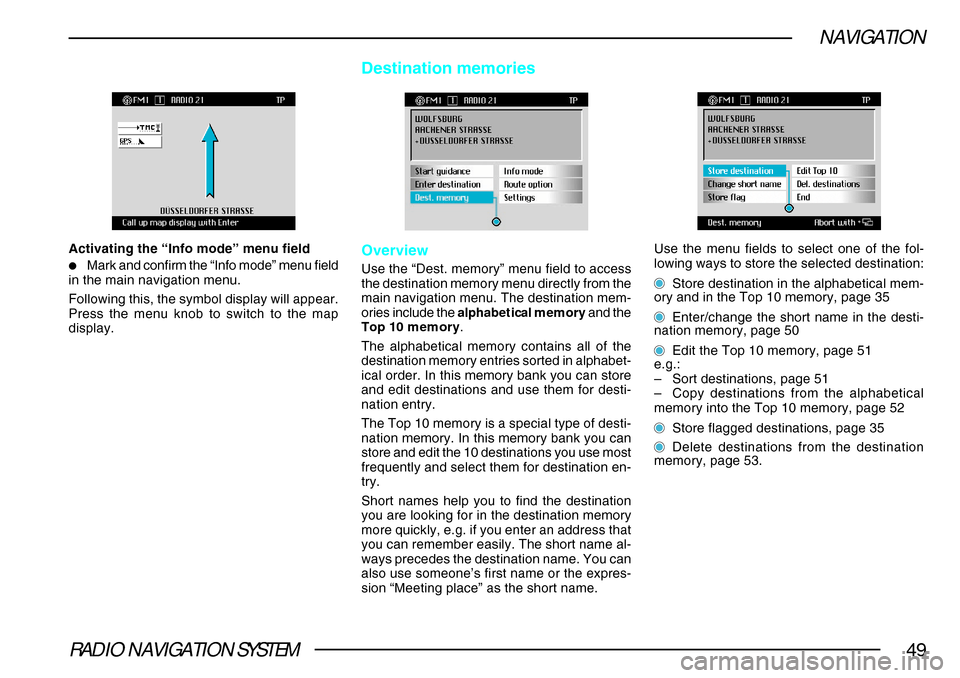
RADIO NAVIGATION SYSTEM49
NAVIGATION
Activating the “Info mode” menu field
•Mark and confirm the “Info mode” menu field
in the main navigation menu.
Following this, the symbol display will appear.
Press the menu knob to switch to the map
display.
Destination memories
Overview
Use the “Dest. memory” menu field to access
the destination memory menu directly from the
main navigation menu. The destination mem-
ories include the alphabetical memory and the
Top 10 memory .
The alphabetical memory contains all of the
destination memory entries sorted in alphabet-
ical order. In this memory bank you can store
and edit destinations and use them for desti-
nation entry.
The Top 10 memory is a special type of desti-
nation memory. In this memory bank you can
store and edit the 10 destinations you use most
frequently and select them for destination en-
try.
Short names help you to find the destination
you are looking for in the destination memory
more quickly, e.g. if you enter an address that
you can remember easily. The short name al-
ways precedes the destination name. You can
also use someone’s first name or the expres-
sion “Meeting place” as the short name.
Use the menu fields to select one of the fol-
lowing ways to store the selected destination:
Store destination in the alphabetical mem-
ory and in the Top 10 memory, page 35
Enter/change the short name in the desti-
nation memory, page 50
Edit the Top 10 memory, page 51
e.g.:
– Sort destinations, page 51
– Copy destinations from the alphabetical
memory into the Top 10 memory, page 52
Store flagged destinations, page 35
Delete destinations from the destination
memory, page 53.